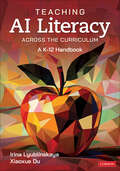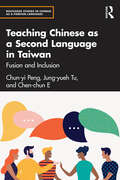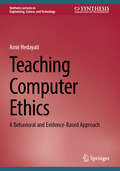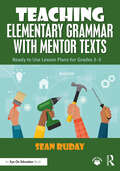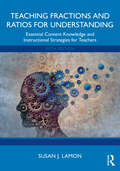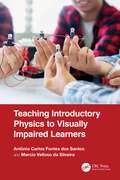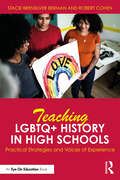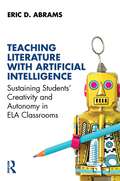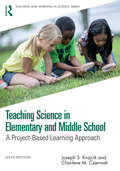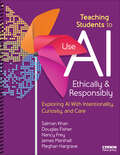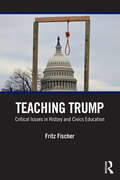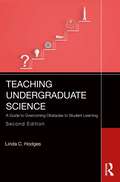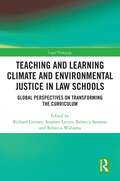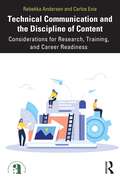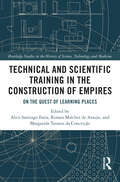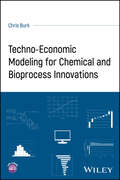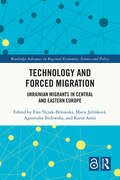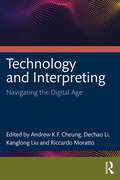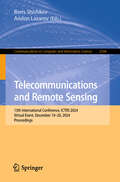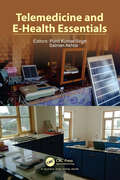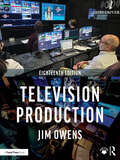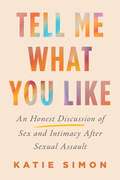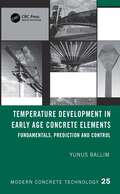- Table View
- List View
Teaching AI Literacy Across the Curriculum: A K-12 Handbook
by Irina Lyublinskaya Xiaoxue DuAI is reshaping the future of education. Are your students ready? In an era where artificial intelligence (AI) is revolutionizing every facet of life, from how we shop to how we get our news, it’s inevitable that AI is changing the way we teach and the way students learn. For students to thrive in this world, they need more than just the ability to use technology; they need to understand how it works, its potential, and its limitations. They need AI literacy. Teaching AI Literacy Across the Curriculum delves into the symbiotic relationship between AI and education, providing cutting-edge research and practical strategies to seamlessly incorporate AI literacy into teaching across disciplines. Authors Irina Lyublinskaya and Xiaoxue Du introduce a pedagogical framework for teaching AI literacy that explores the Big Five Ideas in AI and integrates with practical strategies for teaching AI core concepts across different subjects. Divided into three parts, focusing on theoretical foundations, practical examples, and assessment of AI literacy, this book Offers guidance on integrating AI literacy across various subjects, such as Science, Mathematics, English Language Arts, and Social Studies Provides real-world examples that provoke thoughtful discussions on the ethical considerations and biases inherent in AI Helps teachers to foster critical thinking to ensure that students are well-prepared for the AI-driven future Includes a companion website with access to a wealth of resources such as lesson plans and supplemental materials, templates, and graphic organizers to support AI education in the classroom By weaving AI concepts into the educational tapestry, this book serves as a valuable resource for educators, offering practical strategies and insights to cultivate a generation of learners who are not only technologically adept but also critically engaged with the ethical and societal implications of AI.
Teaching AI Literacy Across the Curriculum: A K-12 Handbook
by Irina Lyublinskaya Xiaoxue DuAI is reshaping the future of education. Are your students ready? In an era where artificial intelligence (AI) is revolutionizing every facet of life, from how we shop to how we get our news, it’s inevitable that AI is changing the way we teach and the way students learn. For students to thrive in this world, they need more than just the ability to use technology; they need to understand how it works, its potential, and its limitations. They need AI literacy. Teaching AI Literacy Across the Curriculum delves into the symbiotic relationship between AI and education, providing cutting-edge research and practical strategies to seamlessly incorporate AI literacy into teaching across disciplines. Authors Irina Lyublinskaya and Xiaoxue Du introduce a pedagogical framework for teaching AI literacy that explores the Big Five Ideas in AI and integrates with practical strategies for teaching AI core concepts across different subjects. Divided into three parts, focusing on theoretical foundations, practical examples, and assessment of AI literacy, this book Offers guidance on integrating AI literacy across various subjects, such as Science, Mathematics, English Language Arts, and Social Studies Provides real-world examples that provoke thoughtful discussions on the ethical considerations and biases inherent in AI Helps teachers to foster critical thinking to ensure that students are well-prepared for the AI-driven future Includes a companion website with access to a wealth of resources such as lesson plans and supplemental materials, templates, and graphic organizers to support AI education in the classroom By weaving AI concepts into the educational tapestry, this book serves as a valuable resource for educators, offering practical strategies and insights to cultivate a generation of learners who are not only technologically adept but also critically engaged with the ethical and societal implications of AI.
Teaching Chinese as a Second Language in Taiwan: Fusion and Inclusion (Routledge Studies in Chinese as a Foreign Language)
by Chun-yi Peng Jung-yueh Tu Chen-chun EThis book focusses on the teaching and learning of Chinese as a second language (CSL) in contemporary Taiwan. It explores linguistic, social, and pedagogical perspectives and offers unique insights into Taiwan’s diverse language landscape, from international students to immigrant learners. Readers will gain an in-depth understanding of how Mandarin is taught and learned in Taiwan, benefiting from the book’s linguistic approach and its examination of multilingualism, teacher education, and immigrant language programs. It provides practical insights for CSL teachers and learners, combining theoretical analysis with real-world examples of language use in Taiwan.This book is ideal for CSL instructors, aspiring teachers, and students interested in learning Mandarin in Taiwan. It will also appeal to scholars studying language pedagogy, and sociolinguistics, and those involved in teacher education programs.
Teaching Computer Ethics: A Behavioral and Evidence-Based Approach (Synthesis Lectures on Engineering, Science, and Technology)
by Amir HedayatiWith the growing use of AI and the introduction of large language models, such as ChatGPT, conversations about ethics have become commonplace. For many, this is the first time they have meaningfully considered the ethical and unethical use of technology in various settings, including education and the workplace. This book reviews the history, nature, and complexity of computer ethics. It discusses the importance of computing ethics education, the process of ethical decision-making among computer science students, as well as misconceptions and biases that impact ethical decision-making.
Teaching Elementary Grammar with Mentor Texts: Ready to Use Lesson Plans for Grades 3–5
by Sean RudayTeaching Elementary Grammar with Mentor Texts: Ready to Use Lesson Plans for Grades 3–5 contains detailed grammar lesson plans for teachers in grades three, four, and five. The lesson plans in this book incorporate the research-based best practices of grammar instruction and apply those practices to the teaching and learning of grammar instruction. They present grammatical concepts in the context of effective writing by using mentor texts. These mentor text examples, which students read from a writer’s perspective, deepen students’ metacognition of the importance of grammatical concepts and help them see the elements of grammar as tools for strong writing that authors use strategically to make their work as strong as possible. The book provides elementary school teachers with user-friendly lesson plans that they can easily use to put mentor text-based grammar instruction into action in their classrooms. These lesson plans feature published examples of grammatical concepts from contemporary children’s and middle-grade books, activities that help students connect their reading and writing experiences, and reflective activities that facilitate students’ metacognition of the importance of grammatical concepts. The thorough plans in this book will help teachers put the best practices of grammar instruction into action in concrete, practitioner-oriented ways.
Teaching Fractions and Ratios for Understanding: Essential Content Knowledge and Instructional Strategies for Teachers
by Susan J. LamonThe fifth edition of this user-friendly textbook helps mathematics educators explore and explain the complex world of rational numbers. It translates research into usable ideas for the classroom, including reasoning strategies, models, and questioning techniques that promote deep understanding that cannot be achieved by merely practicing fraction computation.Updated throughout with new examples and models from research, each chapter in the new edition incorporates samples of student work for teacher analysis, as well as activities for practicing each thinking strategy, designed to be solved without rules or algorithms, using reasoning alone. All content has been used with students and is presented with the learner in mind, acknowledging the brilliance of students' insights as well as the issues that challenge their understanding. It covers a broad range of topics in the progression from relative thinking to proportional reasoning, including fractions, ratios, rates, operators, measures, percents, and more.For over two decades, Teaching Fractions and Ratios for Understanding has helped elementary and middle school teachers expand their understanding and teaching strategies for rational number topics. The fifth edition is essential reading for mathematics courses, teacher preparation courses, graduate courses preparing researchers in mathematics education, and parents engaged in home schooling.
Teaching Introductory Physics to Visually Impaired Learners
by Antônio Carlos dos Santos Marcio Velloso da SilveiraFollowing global inclusion policies and initiatives, more students with visual impairments are attending regular education in inclusive schools. Universities also increasingly accept students with visual impairments in the most varied courses, including engineering and physics. However, teachers do not always have experience with teaching this specific audience. Teaching Introductory Physics to Visually Impaired Learners provides a gateway to understanding the difficulties encountered by this audience and provides ways for teachers to embrace this challenge. The concept of inclusion is discussed in light of the historical evolution of the achievements of people with disabilities and the development of reading and writing in Braille, in addition to other more modern tools, such as cell phone applications. The remaining chapters present methodologies for teaching mechanics, waves, electrodynamics, optics, and modern physics in classes where there are one or more students with visual impairments. The main target audience for this book is elementary and higher education physics teachers and researchers. This book is also of great value to anyone, including teachers from other areas and students with visual impairments, who are looking for teaching materials that facilitate learning for people with visual impairments.Key Features: The first book to help readers understand the difficulties of inclusive physics teaching for students with visual impairment. Allows the reader to have a broader view of what visual impairment is, bringing together theoretical tools necessary to value and promote inclusive education. Encourages the reader to reproduce the physics teaching methodology, with low-cost materials, which facilitates its implementation in the classroom.
Teaching LGBTQ+ History in High Schools: Practical Strategies and Voices of Experience
by Robert Cohen Stacie Brensilver BermanTeaching LGBTQ+ History in High Schools: Practical Strategies and Voices of Experience offers insights, concrete strategies, and lesson plans for teaching LGBTQ+ history in high schools. With essays from educators, historians, and activists, it speaks to the power and significance of LGBTQ+-inclusive curriculum and its greater necessity at a time when the LGBTQ+ community is both more visible and increasingly targeted.Across the US, challenges exist that prevent teaching LGBTQ+ history, including curriculum censorship laws prohibiting discussion of the LGBTQ+ community in schools. However, there are also grassroots movements in the US that are generating quality LGBTQ+ history curriculum and implementing them in secondary schools. This book shows how integrating LGBTQ+ content offers myriad benefits for all students, including making history more relevant and representative, and reversing years of silence and erasure in the sources, topics, and narratives that students encounter throughout their education.Combining insights from changemakers with practical strategies and lesson plans for teaching LGBTQ+ history, this book will equip educators with the rationale and resources they need to effectively integrate this history into the curriculum. It will also be highly valuable for pre-service teachers, particularly within Social Studies Education and Social Justice Education.
Teaching Literature with Artificial Intelligence: Sustaining Students' Creativity and Autonomy in ELA Classrooms
by Eric D. AbramsTeaching Literature with Artificial Intelligence explores the use of chatbots as participants in the teaching and learning of literature in high school and college classrooms while highlighting potentially outmoded norms and expectations of ELA instruction. Artificial intelligence programs have profoundly altered the daily realities of teachers and students, inspiring concern and opportunity alike. Thought-provoking, theoretically grounded, and full of replicable autoethnographic experiments, this book offers real-world examples of generative chatbot technologies in ELA classrooms, positioning their accessibility and ubiquity as an incentive for critiquing and enriching traditional teaching and learning approaches. Graduate students, teaching faculty, and scholars of teacher education, English and literature education, digital literacies, and learning design will come away with a sharp critique of the purported affordances of chatbots as well as an incisive demonstration of AI as a classroom tool that supports, rather than diminishes, the meaningful learning, critical thinking, and agentive development of young people today.
Teaching Science in Elementary and Middle School: A Project-Based Learning Approach (Teaching and Learning in Science Series)
by Joseph S. Krajcik Charlene M. CzerniakThis essential science methods resource integrates principles of learning and motivation with practical teaching ideas for the elementary and middle school science classroom. It employs project-based learning (PBL) to enable educators to engage their students in meaningful, real-world questioning about the world. It provides concrete strategies for meeting the Framework for K–12 Science Education. Chapters offer examples of project-based lessons to help teachers support children in varying modes of inquiry, such as asking critical questions, designing investigations, constructing models, and developing evidence-based explanations.Features in the Sixth Edition include: Instruction on using PBL to make connections to Common Core Standards for Mathematics and English Language Arts An increased attention to assessment for learning A focus on three-dimensional learning. This book is ideal for pre-service and in-service elementary and middle school science and STEM teachers and is designed for use in related methods courses or professional learning opportunities.
Teaching Students to Use AI Ethically & Responsibly: Exploring AI With Intentionality, Curiosity, and Care
by James Marshall Douglas Fisher Nancy Frey Salman Khan Meghan HargraveArtificial intelligence is no longer a distant concept in education. It′s a present-day force reshaping how students learn, and teachers teach. But in the rapidly evolving world of AI, educators need more than just quick fixes or flashy tools. With the guidance of expert educators Salman Khan, Douglas Fisher, Nancy Frey, James Marshall, and Meghan Hargrave, Teaching Students to Use AI Ethically & Responsibly will prepare you not only how to teach with AI-but how to teach for a world transformed by it. Grounded in the latest research and enriched by years of classroom experience, this book takes you from understanding what AI is and how it operates, to helping students become confident, ethical thinkers in an AI-powered world. Organized into three sections, it covers how to teach AI′s foundational concepts, how to develop student inquiry and critical thinking, and how to teach student AI usage through authentic, curiosity-driven learning quests. It includes: Clear definitions, classroom examples, and teacher/student practices for each of the 30 core topics across AI theory, skills, and application Step-by-step guides for nine unique AI-powered learning quests, each designed to drive curiosity, collaboration, and deep understanding Practical strategies for addressing ethical considerations, bias, privacy, and responsible use of AI in learning environments Skill progressions for different grade bands, including skills to master, prompt-crafting tips, and online examples to help both educators and students integrate and evaluate AI tools with confidence Whether you′re new to AI or already exploring its integration, this comprehensive resource sheds light on hidden aspects of AI, equips you to foster essential student skills, and provides actionable strategies for hands-on collaboration with AI in your daily teaching practice.
Teaching Students to Use AI Ethically & Responsibly: Exploring AI With Intentionality, Curiosity, and Care
by James Marshall Douglas Fisher Nancy Frey Salman Khan Meghan HargraveArtificial intelligence is no longer a distant concept in education. It′s a present-day force reshaping how students learn, and teachers teach. But in the rapidly evolving world of AI, educators need more than just quick fixes or flashy tools. With the guidance of expert educators Salman Khan, Douglas Fisher, Nancy Frey, James Marshall, and Meghan Hargrave, Teaching Students to Use AI Ethically & Responsibly will prepare you not only how to teach with AI-but how to teach for a world transformed by it. Grounded in the latest research and enriched by years of classroom experience, this book takes you from understanding what AI is and how it operates, to helping students become confident, ethical thinkers in an AI-powered world. Organized into three sections, it covers how to teach AI′s foundational concepts, how to develop student inquiry and critical thinking, and how to teach student AI usage through authentic, curiosity-driven learning quests. It includes: Clear definitions, classroom examples, and teacher/student practices for each of the 30 core topics across AI theory, skills, and application Step-by-step guides for nine unique AI-powered learning quests, each designed to drive curiosity, collaboration, and deep understanding Practical strategies for addressing ethical considerations, bias, privacy, and responsible use of AI in learning environments Skill progressions for different grade bands, including skills to master, prompt-crafting tips, and online examples to help both educators and students integrate and evaluate AI tools with confidence Whether you′re new to AI or already exploring its integration, this comprehensive resource sheds light on hidden aspects of AI, equips you to foster essential student skills, and provides actionable strategies for hands-on collaboration with AI in your daily teaching practice.
Teaching Trump: Critical Issues in History and Civics Education
by Fritz FischerThis book makes the case for teaching and engaging with the Trump presidency as US political history. Asking questions about how and when Trump’s presidency should be studied posits that history teachers must engage with this history now. The author points to the events that the January 6th Commission called a “stain on our history” and makes the argument that these events, if ignored, could stain the idea of history itself, shrouding it in a mythical haze and relegating history teachers to merely marginalized storytellers. As such, it offers ideas on engaging students with the facts and sources of the Trump presidency and placing Trump in the larger context of American political history. It specifically centers the notion of “historical thinking” as a guiding principle for the teaching of history and the study of the Trump presidency in particular. This book bridges the gap between the controversial events and rhetoric of Donald Trump’s first administration and the importance of contextualizing his presidency in the history classroom. It will appeal to educators, scholars, and researchers with interests in history education and teaching, those interested in civic education and social studies, as well as anyone interested in the future of teaching history and civics.
Teaching Undergraduate Science: A Guide to Overcoming Obstacles to Student Learning
by Linda C. HodgesTeaching Undergraduate Science: A Guide to Overcoming Obstacles to Student Learning offers college and university instructors evidence-based strategies to help students learn those specific skills and habits of mind necessary for succeeding in STEM fields.Updated and expanded from the first edition, this text elaborates on critical factors in cultivating student success, including how to engender a sense of belonging and agency in STEM, engage students in their learning, and foster deliberate practice. Hodges provides frank guidance on the relative effort and outcomes for each strategy, allowing instructors to choose techniques best suited to their aims and contexts. While focusing primarily on face-to-face classes, this resource also addresses how to work between online resources and physical spaces. Hodges’ years of experience working as and with STEM faculty provides a personal connection to the research shared, producing an accessible, practical, and enjoyable read.
Teaching and Learning Climate and Environmental Justice in Law Schools: Global Perspectives on Transforming the Curriculum (Legal Pedagogy)
by Richard Grimes Clemens Kaupa Richard Owen Rebecca Williams Andrea Ross Sean Whittaker Ulrich Stege Kim Bouwer Stephen Levett Rebecca Samaras Hubert Algie Tom Brenan Camila Bustos Abigail Fleming Isobel Graham Arpitha Kodiveri Christina Mosalagae Ashley Nemeth Michael Robinson-Dorn David Rossati Douglas Ruley Harrison Singh Parker Vize Sue WillmanArguing for the critical importance of the topic within law school curricula (whether for academic credit purposes or not), this novel and exceptionally timely book explores a fundamental question: should law schools teach about climate and environmental justice?Despite the urgency of climate and environmental protection issues, many law schools present the topic as optional for students or don’t engage at all. Arguing for the inclusion of climate and environmental justice at the earliest possible opportunity, this book presents study models in a variety of contexts and jurisdictions to support research into curriculum development and design. Case study examples of planned climate and environmental justice research and offerings at national and international levels are presented to support those who wish to include and/or expand provisions. This book also addresses concerns and initiatives of indigenous peoples, demonstrating how partnerships between law schools and others remain integral to establishing sustainable learning initiatives.Ultimately promoting and supporting the study of climate and environmental justice in a legal and applied context, this book will be of interest to scholars, researchers and academics involved with sustainability education, training and leadership, legal education and curriculum design. Clinical legal educators may also find the volume of interest.
Technical Communication and the Discipline of Content: Considerations for Research, Training, and Career Readiness (ATTW Series in Technical and Professional Communication)
by Carlos Evia Rebekka AndersenThis book explores how workflows and technologies that treat content as computable data are changing the roles, work activities, and outputs of professional technical communicators.It describes how the need for disciplinary approaches to design, manage, and deliver content has given rise to “the discipline of content” – content strategy, content design, content engineering, content operations – that increasingly defines a facet of technical communication work in modern organizations. This book draws on extensive research of the discipline of content and dozens of interviews with industry leaders, hiring managers, and academic administrators, educators, and alumni. These first-hand accounts outline how roles and activities in content organizations are changing, how these changes are impacting hiring needs and practices, and what skills and qualities students and early-career professionals now need to obtain content-related jobs and advance to strategic positions. This book also offers guidance for building curricular pathways that prepare students for work in the discipline of content and offers strategies for enhancing pathways through industry outreach and partnerships.A thorough assessment of the implications of the discipline of content for technical communication, this book will be of interest to students and scholars in the fields of technical writing, professional and public writing, content strategy, content marketing and information design.
Technical and Scientific Training in the Construction of Empires: On the Quest of Learning Places (Routledge Studies in the History of Science, Technology and Medicine)
by Alice Santiago Faria, Renata Malcher de Araujo, and Margarida Tavares da ConceiçãoThis book proposes a comparative reading between formal, or non-formal, structures of learning and individual agency abilities, highlighting influences and entanglements in different geographies from multiple spheres of knowledge and practices.“Learning Places” is an expression that intends to underline the very nature of technical and scientific knowledge transmission related to the built environment transformation of imperial colonial areas. This volume proposes an approach that emphasises the crucial role of the connection between individual and institutional levels, forming a complex network of Learning Places. By comparing different case studies in fields of knowledge and transformation of the built environment—military engineering and cartography, among others—the book establishes a comparative frame of the political-scientific enterprise of empires, across geographies and times.Technical and Scientific Training in the Construction of Empires is of key interest to researchers, teachers, and students of a variety of disciplines, including the history of science and technology, architecture and urban studies, and colonial and post-colonial studies.
Techno-Economic Modeling for Chemical and Bioprocess Innovations
by Chris BurkBuild spreadsheet-based techno-economic models to understand factors driving economic value Techno-economic modeling examines how technical and financial parameters influence the economic value of a technology at the commercial scale. Techno-Economic Modeling for Chemical and Bioprocess Innovations is a practical guide to building spreadsheet-based techno-economic models and using them to make better decisions on the road to market. Inside, this book: Explains the role of techno-economic modeling in advancing new technologies toward commercialization.Presents spreadsheet best practices that form the foundation for effective and efficient techno-economic modeling.Teaches how to combine process modeling, equipment sizing, and cost estimation in a cohesive and usable spreadsheet model.Introduces techniques for analyzing model results to assess economic viability, quantify uncertainty, inform R&D priorities, and improve stakeholder communication.Provides practical Excel and VBA examples, with two complete sample models available online. This book equips readers with the tools to combine science, engineering, and cost estimation. It is an essential resource for chemical and bioprocess engineers, including academics, startup teams, and advanced students working to bring innovations into the world.
Technology and Forced Migration: Ukrainian Migrants in Central and Eastern Europe (Routledge Advances in Regional Economics, Science and Policy)
by Ewa Ślęzak-Belowska Marie Jelínková Agnieszka Bielewska Karin AmitThe Russian aggression on Ukraine has drastically altered the migration situation in Central and Eastern Europe (CEE), drawing international attention. Despite numerous global studies on individuals seeking refuge, CEE remains underresearched. This book details the recent, lesser-known experiences of countless forced migrants who arrived there.Given the pivotal role of information and telecommunication technologies (ICTs) for both migrants and host societies, the book explores the intersection of ICTs and forced migration. With this in mind, the book focuses on Poland, Czechia, Slovakia, and Hungary, and uses comprehensive research and robust qualitative methods to demonstrate how these countries are emerging as New Immigration Destinations and handling the influx of Ukrainians. Contributions from economists, sociologists, and political scientists provide a thorough examination of how Ukrainian forced migrants navigate their lives using modern technologies, as well as their impact on these technologies.Essential reading for academics, policymakers, and professionals in the fields of migration studies, digital governance, and European affairs, this book uniquely highlights the vital role of ICTs in migration decisions, journeys, settlement, and integration. It provides a balanced mix of theoretical analysis and practical insights, helping readers comprehend the interplay between ICTs and migration. Readers will obtain a better understanding of the challenges and opportunities that digital technologies bring in facilitating and regulating forced migration in this part of Europe.
Technology and Interpreting: Navigating the Digital Age
by Kanglong Liu Riccardo Moratto Dechao Li Cheung, Andrew K.F.Offering a thorough exploration of the rapid advancements in technology development for interpreting, this book explores the effects of technology on the practice of interpreting, providing theoretical insights and practical applications.The chapters underscore the interdisciplinary nature of interpreting in the digital age and cover a wide range of topics from online learning environments for trainee interpreters and ethical considerations to the application of specific digital tools in language interpretation. It covers the application of advanced language models in interpreting, the pedagogical implications of technology in interpreter training as well as the cognitive aspects of interpreting in a technologically advanced environment. The authors integrate insights from technology, linguistics, education and cognitive science to provide a comprehensive understanding of how technology influences interpreting. This interdisciplinary approach allows the book to provide a holistic view of the field, making it a valuable resource for readers from various disciplines interested in the interplay between technology and interpreting. This book serves as a platform for discussing and debating new thoughts on the teaching and training of interpreting and the delivery of interpreting services.Delving into the new paradigms of interpreting studies that have emerged in the wake of technological advancements, this book will be invaluable to students studying interpreting or related fields, researchers investigating the impact of technology on interpreting and practitioners in the field who are keen to understand and leverage the latest technological advancements.
Telecommunications and Remote Sensing: 13th International Conference, ICTRS 2024, Virtual Event, December 19–20, 2024, Proceedings (Communications in Computer and Information Science #2544)
by Boris Shishkov Andon LazarovThis book constitutes the revised selected papers of 13th International Conference on Telecommunications and Remote Sensing, ICTRS 2024, held as a virtual event, during December 19–20, 2024. The 7 full papers and one short paper included in this book were carefully reviewed and selected from 19 submissions. They focus on topics such as Wireless Telecommunications and Networking, Electromagnetic Waves and Fields, Electronics and Photonics, Remote Sensing and Data Interpretation, Remote Sensing and Internet-of-Things and Societal Impact.
Telemedicine and E-Health Essentials
by Salman Akhtar Punit Kumar SinghTelemedicine and E-Health Essentials presents a comprehensive analysis of virtual healthcare systems transforming modern medicine. From basic telephone consultations to advanced digital platforms, this book explores how remote healthcare technologies are improving medical access and patient outcomes. Through evidence-based examples, it examines successful applications in emergency care, specialist consultations, and remote monitoring while addressing key implementation challenges in data security, provider training, and regulatory compliance. The COVID-19 pandemic's influence on accelerating virtual care adoption is analyzed with practical insights. This essential resource guides healthcare administrators, clinicians, and policymakers in optimizing telemedicine integration for enhanced healthcare delivery.
Television Production
by Jim OwensGain the skills you need to succeed in the television industry and master the production process, from shooting and producing, to editing and distribution. This new and updated 18th edition of Television Production offers a thorough and practical guide to professional TV production techniques. Learn how to anticipate and quickly overcome commonly encountered problems in television production as author Jim Owens details each role and process, including the secrets of top-grade camerawork, persuasive lighting techniques, and effective sound treatment, as well as the subtle processes of scenic design, directing, and the art of video editing. Updated throughout, with over 130 new figures and diagrams, the 18th edition of this classic text includes: A discussion of the changing definition of "television" and how new technology alters viewing habits Interviews with professionals in the industry about the challenges they face during the production process and the advice they would give to those trying to break into the production and television industries A review of AI and television production An examination of the growing use of smartphones in professional television production A discussion of how cloud-based production is impacting television production A description of the latest cameras and equipment, including LED lighting and remote production Guidance and techniques for low-budget, DIY-style productions A comprehensive resource page for instructors, containing slides and testing materials to aid in the learning process can be found at www.routledge.com/9781032640983.
Tell Me What You Like: An Honest Discussion of Sex and Intimacy After Sexual Assault
by Katie SimonHopeful, groundbreaking, and anchored in true stories, this much-needed book from sexuality journalist and fellow sexual assault survivor Katie Simon delves into the challenges of moving from trauma to healing. Tell Me What You Like will guide sexual assault survivors toward the sex and relationships they want, and speaks to the shift in sexual culture we all need. Over a decade ago, Katie Simon began seeking out stories of people who faced sexual challenges after sexual trauma—just as she did. Simon interviewed dozens of survivors, and her investigation yielded diverse responses from people of all backgrounds, ultimately confirming that there is no single path toward healing. Simon&’s research led her to life-changing findings that sexual assault survivors most want to know about, including coping with trauma triggers and traumatic stress symptoms such as anxiety, depression, physical pain, and flashbacks. From embodied consent to self-pleasure, sexual regret, breakups, and beyond, you&’ll find answers to all your questions about how sexual trauma affects sex and relationships within these pages, in stories told by survivors who&’ve actually been there. Millions of survivors across the United States are treated as irreparably broken. Simon offers a positive approach to healing based on empathy and community—and the understanding and tools to navigate trauma and cultivate the sex lives we desire and deserve. The narratives Simon has gathered break down the potential obstacles to rebuilding post-assault, and offer multiple paths forward with optimistic, new approaches to sex after sexual assault. Packed with insights, stories, and advice, this invaluable guide reimagines what sex can look like—not only for survivors, but for all of us.
Temperature Development in Early Age Concrete Elements: Fundamentals, Prediction and Control (Modern Concrete Technology)
by Yunus BallimThe focus of this book is to provide guidance on the prediction of time-temperature profiles in large concrete elements during the early stages of construction, with a view to minimising the likely damage that may occur to the concrete as a result of elevated temperatures caused by the heat of hydration of the cementitious materials. Early-age elevated temperatures in concrete elements create the potential for cracking of the structure as well as compromising the strength and durability of the concrete.The book provides details on the characteristics of cementitious materials and their effects on the rate of heat evolution as well as the effects of elevated curing temperatures on the physical, mechanical and durability properties of concrete. The book also considers the effectiveness of materials selection and construction methodologies for early-age concrete temperature management and control. Several case studies are presented to illustrate the important aspects in the design and construction of temperature-sensitive concrete structures.This book is primarily aimed at practicing design and construction engineers who are concerned with thermal effects and stresses in large concrete elements. It is also aimed at researchers and postgraduate students who may consider aspects of this wonderfully complex matter of heat transfer and temperature prediction in large concrete structures, as sufficiently interesting to warrant further research and investigation.
